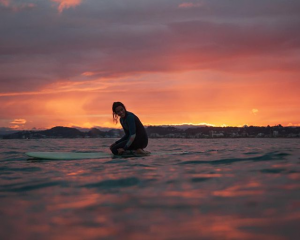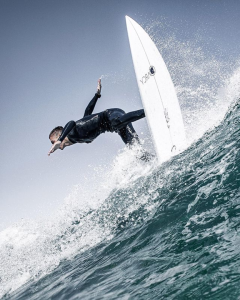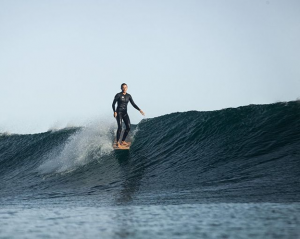Surfboard
How to Pop Up Faster on a Shortboard
Everyone is a beginner at first. No one has become a professional in a day.
Well, if you’re surfing for fun, the word effort may not be appropriate, but if you dare to give me some advice, only when you’re a beginner you should do your best and graduate from that level early. It’s after I’ve been able to “ride the waves” that I realize the fun of surfing.



An excellent way to help beginners graduate is to practice on a “user-friendly” surfboard.
It’s a big mistake if you think, “Because I’m a beginner, I don’t care about surfboards.” On the contrary, when you are a beginner, you should practice with a surfboard that makes up for that immaturity.What are the criteria for choosing the right board for beginners?
For a long time, the theory has been that a “buoyant board” is good. However, it has not discussed that even if there is too much buoyancy, it will be handicapped.Recently, it has become possible to measure surfboards by the number of litres, but that alone may not speed up the takeoff. So, I would like to introduce a new standard for surfboard selection with explanations that even beginners can understand. It may be full of dogmatism and prejudice, but you can listen to it as a story.
Beginners will find the size that suits them with new ideas
Your progress in surfing accelerates when you focus on your “toes.” First of all, the criteria for beginners to choose a shortboard is whether they can pop up using their “toes”. Today’s conventional shortboards are often less than 6 feet (183 cm) long. At this length, if the surfer is over 170 cm tall, the toes will stick out of the board when paddling, and the toes will not be usable when popping up and will have to pop up at the kneecap. So it is pretty tricky for beginners.(Pop-up: The action of standing up on the board from the paddle position)
To be able to pop up on your toes, you need a surfboard with a height of + 30-40 cm. So, for example, if you’re 170 cm tall, you’ll get 210 cm (6’9 “) plus 40 cm. You might be surprised to hear this length, but popping up with your toes is super easy. You can see the difference by trying the pop-up with only the toes. Paddles aren’t the only reason why shortboard surfing is brutal. It is because pop-ups are complex and takeoffs delay. The solution is to stand on your toes to make the pop-up easier. Unfortunately, the only way to do that is to lengthen the surfboard. Even if you increase the surfboard volume, it will not solve the pop-up unless it becomes long.Whether your toes get on the board or not, that’s the new standard.
“Beginners should start long” is not 100% correct. 9 feet (274 cm) is the standard for longboards. But this is just regulation of the match, and the number 9 is meaningless if you don’t play in the game. 9 feet is too long for just riding the waves, and most beginners can’t afford it. Especially for small women (60kg and up), a 9-foot longboard is like fighting a rampaging horse in the ocean. When she goes offshore, she’s almost blown away by white water, and when she has no control. When wiped out and dragged by a leash, it’s like a western cowboy. In other words, it’s like riding a Harley and practising a motorbike. Isn’t 250cc enough for bike practice? Aside from the definition of a longboard. 8 feet (243 cm) is sufficient for beginner surfboards when considering paddles and takeoffs. One foot (30 cm) shorter makes it easier to carry the surfboard. It will be possible to load in the car, it is suitable for the housing situation in Japan, and there are plenty of elevators. If you weigh less than 60 kg, 7 feet is delicate. A surfboard that is too wide will interfere with the paddle. Instead, hold it aside and see if you can reach it. The width of the surfboard is measured by whether it can hold with one hand. Now, let’s think about the width of the longboard. Can a person who has my board hold it in the palm of his hand when he holds it aside? How much can you turn with the surfboard deck on your side? Whether or not you can grab the rail with your palm is one of the decisions. If you don’t even get your fingertips, the surfboard is too wide for you. If it is too wide, the paddle will be affected. The paddle must submerge in the sea up to the elbow, but if the surfboard is too wide, it will spread your arms and become a paddle that you can row shallowly with just your hands, losing power. It’s a lot of work for beginners if you can’t hold your surfboard aside when you walk on the beach. Furthermore, even when turning on the waves, the wide board has strong resistance when tilted and is difficult to control. Making a custom-made surfboard is also an effective way to graduate from beginners early.
Summary:
At 8 feet or less and moderately broad, the mid-length that’s trending now is the right size. You can also pop up with your toes. However, if you’re on a 9-foot board and scale down, you’ll find it a little harder to take off because until then, you’ve relied on buoyancy to take off. However, you can overcome it by brushing up the paddle and takeoff timing. If you scale up from a shortboard, you will be worried about the length of the board, and the feeling of sliding sideways on the face will increase. Still, without resisting that feeling, you can accelerate while using the length and glide and a deeper bottom. Aiming for the top turn from the turn will dramatically change your surfing. Pop-ups with toes make you feel positive when you have more time to take off. Its priority is excellent. The point to be careful is not to bend the chest “only” at the moment of takeoff. If you turn your chest “only”, the surfboard will start to slide, and your legs will not come out at the moment of launch. The reason is that the waist is close to the surfboard.- Lift your upper body with your hands like a vaulting box and at the same time raise your hips
- Stand up as it is

In paddling, look in the direction of travel.
For paddling before takeoff, look in the direction of travel. If you look down, you lose your balance. What is essential for paddling is that there is no blurring and that the axis does not shift. Therefore, it is necessary to absorb the shaking with the chest, abdomen, and thighs to maintain a sense of stability.- The position of the hand is slightly closer to the nose of the chest.
- As for the position of the hands, doing push-ups, and the chest is a little closer to the nose.
- If you grab the surfboard, the extra force will be transmitted to the surfboard, creating instability and slowing down the takeoff.
- Just feel like you’re flying in a vaulting box, and try raising your hips quickly.
- At the moment of takeoff, it is essential to raise your hips to lift your upper body without bending your chest.
- I want to create a posture that makes it easy to put out my front legs at that momentary timing. Therefore, it is essential to develop a posture that makes it easy to raise your hips and put your legs forward.
- When you touch it, push up your upper body at once and lift your butt with the same momentum.
- Raise your hips and push your front legs to the stance position at once.
- When you put your foot in the stance position, do not stand up in a hurry, but put your weight on the surfboard and accelerate while looking at the direction of travel.

